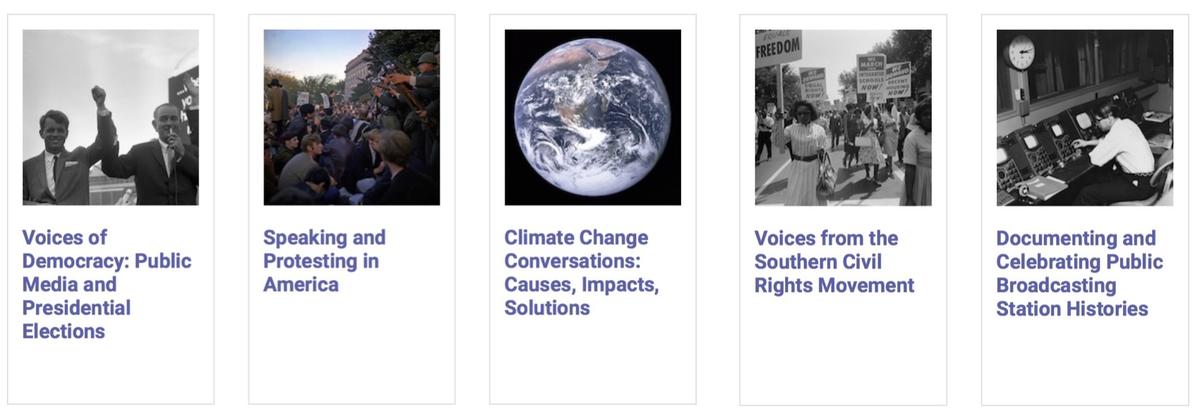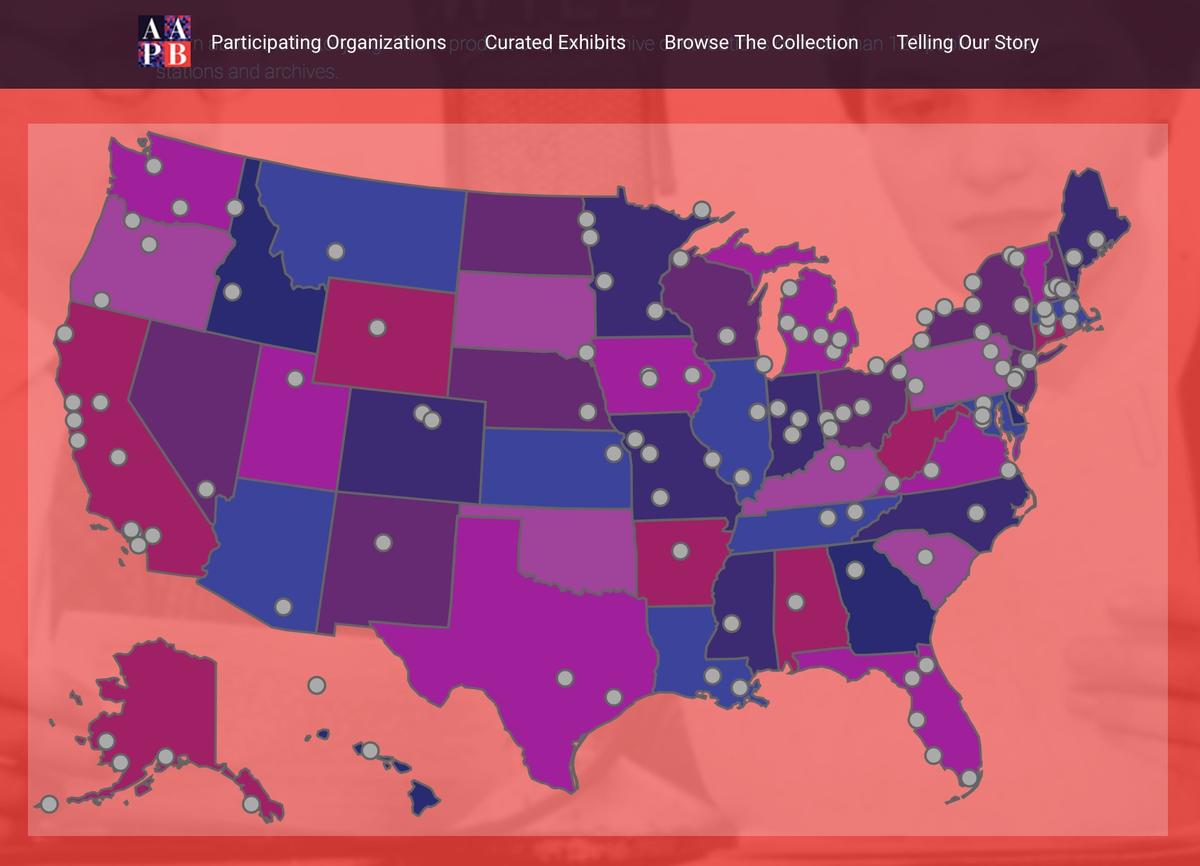“The American Archive of Public Broadcasting,” accessed November 15, 2016, http://americanarchive.org/ (Library of Congress & WGBH Media Library & Archives)
Robert Cassanello, University of Central Florida
The American Archive of Public Broadcasting (AAPB) is an online digital repository for radio and television programs created by one hundred and twenty public radio and television stations across the country. The Oscar’s Science and Technology Council’s recent study found that curators of these types of collections are careful to explain that sites like this which digitize analog copies of audio and film for distribution and viewing on the internet are libraries and not archives or a catalog for media creators to purchase full size content.[1] For digital preservationists, archives maintain the original film artifacts really the hardcopy in a way an archive might house original diaries, letters or other types of unpublished manuscripts. Catalogs serve a purpose for filmmakers and documentarians who can use those sites to browse or search small sized watermarked items for potential use in a film, television program or other media projects. These library sites instead serve the purpose of digitally preserving and widely disseminating analog and digital programing online. Causal users who might interact with these three different types of digital repository platforms interchangeably refer to these sites as an archive, library or catalog but each are distinct and serve a very different objective and audience.
This site follows a number of other media archives that collect historic radio and television programs. The Prelinger Archives is the most popular and is housed at the Internet Archive. The Prelinger Archives hosts over sixty thousand pieces of film representing what the curators refer to as “ephemera” made up of amateur, industrial, educational and advertising films. AAPB is organized very differently from the Prelinger Archives, however, and is more user friendly in assisting the user in not only engaging with the content but helping a researcher locate material. For the causal viewer, he/she can browse materials and select audio or videos of interest and watch them on the site and learn more about the content and production of the program right at the page. A researcher can also do these things including searches with copyright information and a correct citation listed on each item’s page.
One should note that the items housed at AAPB are carefully produced national and local news programs about issues and subjects facing American society during different moments in time. The mission of the organization is to preserve this content and make it free and accessible online for “scholars, educators, students, journalists, media producers, researchers, and the public, for the purpose of learning, informing, and teaching,” which is in keeping with its objective as a library style site. The AAPB houses forty thousand hours of historical audio and video broadcasting that is available currently online and visitors to the site can search an entire database of over two and half million items that are stored in archives around the country some of which has been digitized and others are not and are still in its original analog format awaiting digitization.
The site does not explain its methods for prioritizing the digitalization and eventual distribution of items on its library site, however there is a growing literature on the practice with no set standard in place.[2] Since there is no discernible commercial profit to the AAPB , the decision to house items in the library was probably based on some combination of the quality of the original artifact, the item’s historical significance and some consideration to geographical and chronological representation. There is a page that provides the individual the ability to donate to the site to maintain it and help to continue to process materials for online open access as outlined by the mission of AAPB.
For the visitor with a research topic in mind, the library works well to search for items by keyword, geographical buttons on the browse page, and subject tiles that represent the most popularly searched terms. For those visitors without a research agenda there is a “Curated Exhibits” page where items are featured under broad topics that might pique the interest of not only the researcher or teacher but also the casual browser. The “Curated Exhibits” page is a striking feature to the site because it allows guests to explore topics that might be of interest and like many local libraries across the country it is not unusual for residents to see their local library host traveling and sometime permanent exhibits. What is different here is that the material of the exhibit is made up exclusively of items from AAPB’s own collection and provides a point of interpretation for specific topics important to the American past during this age of public radio and television. The exhibits page features “Voices from the Southern Civil Rights Movement,” “Voices of Democracy: Public Media and Presidential Elections,” “Climate Change Conversations: Causes, Impacts, Solutions,” and “Documenting and Celebrating Public Broadcasting Station Histories.” Each page features a brief essay about the content and overview of the specific items selected as well as mention of the individual curator who put the exhibit together with resources to locate other programs not featured on the site but are in media and radio archives around the country. The exhibit pages are pretty bare visually as far as digital installations go. The individual exhibits do not host or provide much if any interactivity or discussion and engagement that you might find or expect in digital history projects online. It is a storehouse for items related to a specific topic with some text to support the materials there and explain its value to potential researchers.

If one were searching for a specific subject or just browsing items in the collection and then selected an item from a curated page or search engine one will encounter the “Online Reading Room Rules of Use” page. On this page a visitor learns of the rights, permissions, and copyright claims to the collection as well as the definition of “Authorized” user which are those people who use the items in the collection as spelled out in the agreement on the page. There also is a category of “Password-Protected” users who can use materials not freely available online but requested through the managers and curators of the collection. The staff of the American Archive of Public Broadcasting site does this for material not in wide circulation or possible analog materials that are being digitally processed specifically for request. This might raise some concerns as to what materials are left behind a password protected page and those which are free to the public, there is no explanation of what those materials might be. For all open access materials, each item can be viewed on its own page which houses all the necessary information to not only view it online, but its provenance as well as the preferred citation. For researchers, teachers, and the casual visitor the site offers a great deal, a search engine, multiple browse pages and an exhibits section, and the site is easy to use and navigate. For media repositories that are interested in hosting their digitized collections online, this site offers a wonderful example of how to organize content, curate collections and provide researchers or other visitors the information they might need to use media content for research or classroom purposes.
Historian’s Take-Away
In some very real sense this is an important site for researchers, teachers, and the like, but it is also important for advocates of public television and radio as well as other institutions that promote the public good and are now under threat by fiscally conservative state and federal politicians who see no value in publically produced media content. This was probably one of the reasons AAPB Metadata Specialist Sadie Roosa (WGBH), was asked to curate an exhibit titled “Documenting and Celebrating Public Broadcasting Station Histories.” Roosa argues that these local radio and TV stations are not only important to the development of America’s broadcast history but “each station’s history is unique and tied closely to the community it serves.” Although the site offers free and open access to the materials it puts online and can be a boon to researchers, it is also evidence of the many benefits of public broadcasting from the federal level to the local. Maybe the site is a magnet for people who already accept the idea of the good of public media as fact, so these materials are preaching to the choir. But as more researchers and more publications cite, link and point readers to the American Archive of Public Broadcasting, an appreciation of what public media does and contributes to our public sphere might grow outside to include those who are unaware or skeptical of public radio and television’s true value.
[1] See “The Digital Dilemma: Strategic Issue in Archiving and Accessing digital Motion Picture Materials,” Los Angeles: Science and Technology Council of the Academy of Motion Picture Arts and Sciences 56 (2007): 1-74
[2] Suzanna Conrad, “Analog, the Sequel: An Analysis of Current Film Archiving Practice and Hesitance to Embrace Digital Preservation.” Archival Issues 34, no. 1 (2012): 27-43, Paul Conway, “Archival Preservation Practice in a Nationwide Context.” The American Archivist 53, no. 2 (1990): 204-22, Richard Wright, “Digital Preservation of Audio, Video and Film.” VINE 34, no. 2 (2004/06 2004): 71-76, for a detailed flow chart of this process see Karen F. Gracy, “Documenting the Process of Film Preservation.” The Moving Image: The Journal of the Association of Moving Image Archivists 3, no. 1 (2003): 1-41.; The Television and Film industries have produced their own guides, The Association of Moving Image Archivists, “Local Television: A Guide to Our Heritage,” National Academy of Television Arts and “The Digital Dilemma: Strategic Issue in Archiving and Accessing digital Motion Picture Materials,” Los Angeles: Science and Technology Council of the Academy of Motion Picture Arts and Sciences 56 (2007): 12

